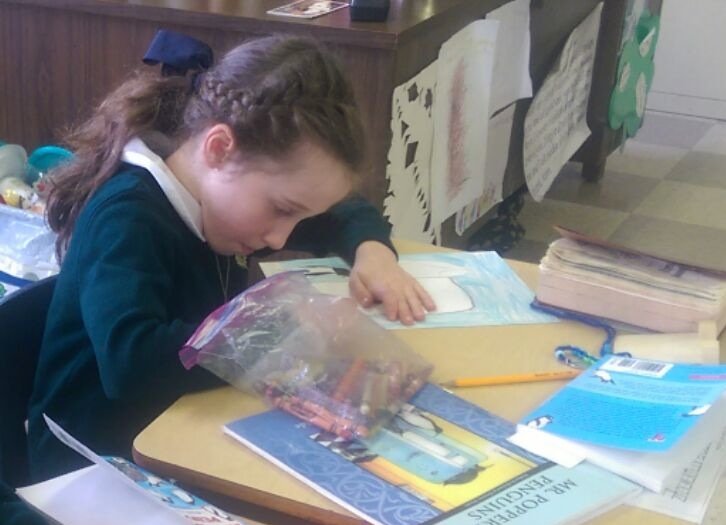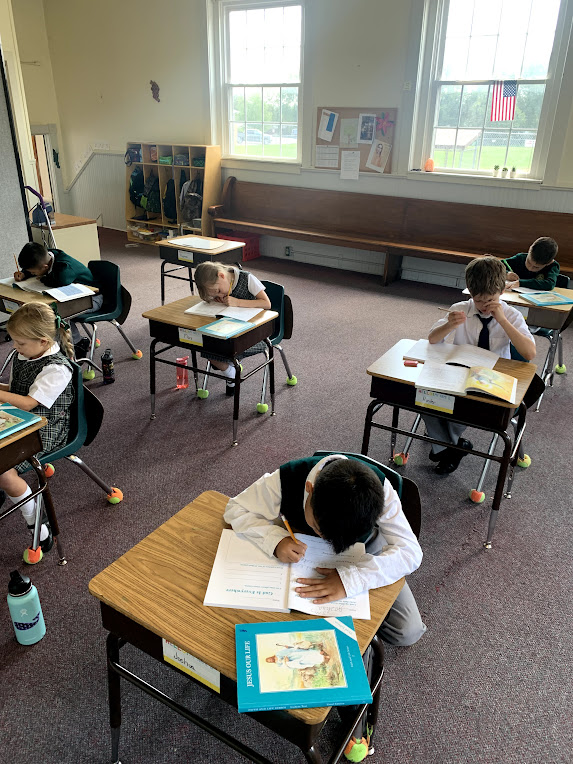Kindergarten transition to First Grade
The five-day Kindergarten program is a wonderful transition between the Montessori preschool program and readiness for 1st grade. Like the Catholic Classical model, the Montessori Program exposes the children to all that is true and good and beautiful. As children so naturally understand, our Father and Creator in heaven is worthy of our praise. The world around us is beautiful and we should learn about it in order to care for it. In caring for it, we care for ourselves and our loved ones. As created human beings, it is important that we treat each other with courtesy and respect. Montessori is foundational in helping children know what that means and what it looks like. The children in this class are highly engaged and the atmosphere is one of calm. Beauty is what inspires our spirits. Montessori introduces the children to beauty in creation, in art, in each other. The children learn cursive, which serves the dual purpose of increasing attention and focus while enhancing their creative skills. Many of the future concepts of math and language are taught in a very concrete way. All of this is foundational in instilling a love of learning at the beginning of a child’s academic experience. And this love of learning is a gift they will carry with them all the way through the completion of their Catholic Classical education and into life.
Primary K-2
Reading, writing, spelling, and arithmetic are the foundation upon which all other learning is built, and they are given the highest priority in K-2. The basic skills, work habits, and attitudes formed in the primary years are of critical importance.
Phonics and Reading
Phonics is the system of letter-sound association taught to children for the purposes of learning to read and spell. Phonics is most effective when taught systematically, thoroughly, and in a logical and time-tested sequence.
Our phonics instruction in kindergarten teaches correct pencil grip, manuscript form, consonant and short vowel sounds, three-letter word formation, consonant blends and long vowels/silent e. Common words, which do not fit into any word family, are introduced after students learn to blend three-letter words. Students learn to read in kindergarten using stories with a high percentage of phonetic words.
Phonics and spelling continue in 1st and 2nd grades with 1st graders continuing to develop reading comprehension with whole books, which captivate and motivate children. Teachers monitor student reading skills through daily oral reading of children’s classics. Spelling, penmanship, composition, and vocabulary lessons for each book are contained in Memoria Press study guides.
A rich language experience, provided both at home and in school, is an important factor in reading success. Students memorize poems and Scripture and enjoy children’s classics read by teachers and parents during read-aloud time.
Spelling and Printing
Students develop the visual memory for accurate spelling by a systematic study of phonics, word families, and spelling rules, and by a lifetime of seeing, reading, and writing words correctly. It is very important to reduce opportunities for children to write or see misspelled words; young students who are allowed to spell creatively or phonetically have a confused visual memory that is difficult to overcome.
Copybook is an exercise consisting of copying sayings, maxims, Scripture, and poetry in the student’s best handwriting. Copybook is an important step in developing good penmanship, punctuation, and spelling. Habits of good penmanship are instilled early and required at every grade level. The discipline of neat and legible handwriting is an aid to spelling and instills the value of accurate, careful work – an important academic skill that carries over into every aspect of learning. In the 1st and 2nd grades students continue to practice manuscript while also beginning cursive script. Cursive is required for written work in grades 3 and up.


